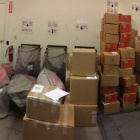Michael Meissner
Member Since: January 2, 2013
Country: United States
-
Thanks for the answers.
2) Hmmm, at 50mm, that is a little bigger than the 16 LED neopixel ring (44.5mm), so for goggles, you probably would want to use the 90L/90R.
3) I don't recall the hookup guide being live initially, but I probably just missed it.
4) Yeah, you can do white by mixing RGB, but with the RGBW you get white a specified color temperture. One of the things I want to do is use the LED ring as a light for a camera, and it helps if the light source is a known temp, but in the grand scheme of things, I can just do color balance in post processing.
8) I know with neopixels/ws2812b, I can sometimes get it to work with 3.3v signal and 5v power (particularly with the older ones), but it is better to do the shifting if it isn't guaranteed, since you might get a new LED string that is pickier.
10) If the datasheet says 5v (and not 3.5-5.5v), then I guess I would need a boost circuit if I was using a LIPO battery (or just use a USB battery instead).
11) In terms of power draw, it is a little more than neopixels/ws2812b (16-20mA per LED, or 50-60mA for the pixel, depending on the source, and when the source was written).
-
A couple of questions about the 90L/R and Lumenati in general.
1) I assume to make a full circle, that you want 4 90L's or 4 90R's (i.e. you want them all in the same direction). Is this correct?
2) If you make a circle, what is the inside diameter of the circle that is open, and what is the outside diameter? I would suspect that it is roughly the same size as the Adafruit 12 LED neopixel ring, which has an outer diameter of 36.8mm / 1.5", and an inner diameter of 23.3mm / 1", but it would be nice to be sure before ordering these.
3) In terms of sizes, would the 8-pack or the 4-pack fit inside of the ring made by 4 90L's?
4) While 12 LED rings are useful, do you have plans for slightly larger 90L/90R variant that has 4 LEDs inside to make a 16 LED ring, which tends to be the right size for mounting on goggles.
5) Some of the WS2812B/neopixel and APA102/dotstar variants have 4 LEDs inside (red, green, blue, and white). Do you have plans for RGBW leds?
6) With WS2812B/neopixels, it is often recommended that you put a beefy capacitor between ground and 5v just before the first LED to smooth over timing issues from external power supplies. Is this recommended for the Lumenati as well?
7) Similarly, another recommendation for WS2812B/neopixels is to put a resistor between the data pin and the microprocessor. Is this needed for the clock/data pins on the Lumenati? I assume that it is less needed, since APA102's use a clock wire instead of having to have a fixed timing sequence, but it doesn't hurt to ask.
8) In your write up it says the data pins are 0-5v. I assume this means that if I'm using a 3.3v board, I have to use a level shifter. Is this correct? Or can I feed it 3.3v data/clock signals without having to use a level shifter?
9) Due to the fixed timing window of WS2812B/neopixels, it isn't useful to use them with POV (persistence-of-vision) applications, because the timing window was to slow. Can the Lumenati be used with POV assuming you have a fast enough processor?
10) The spec for WS2812B/neopixel says that it works for 3.5 - 5.5 volts, which means for a 3.3v microprocessor, I can use VIN to power the LEDS and use the data pin without having to do level shifting. If I'm running off of a single cell lipo battery with a nominal current of 3.7 volt and using a 3.3 volt processor like the Teensy, can I skip the level shfiter?
11) What is the maximum power draw for each LED if I put all 3 colors at 255?
-
It depends on which headers. If you are talking about standard male headers, then yes, you can buy the 40 pin sets of headers and cut them down to size.
However, for female headers, particularly stacking headers, it can be an interesting exercise to find the right size headers. Yes you can cut down larger headers, but then you need to use a dremel or sander to smooth down the edge, and you can't group multiple headers together without sanding. I've been searching for 14 pin stacking headers (for Teensy) for some time.
-
FWIW, I generally prefer to have headers soldered on and I will pay a few $ for it. Can I solder, yes, but I'm not that good at it. Any soldering project involves a lot of checking to make sure I didn't leave any solder bridges and connected the things that need connection. So, I would rather order stuff with headers attached.
-
Shirley: In terms of compatibility, evidently the pad for the reset pin changed location in the Teensy 3.2 compared to the 3.1 In addition, the pads for USB D-/D+ also changed location. Unless you actually use the 3 pads or use one of the third party shields that had a pogo pin to bring out the reset pad to a pin, it should not present a compatibility problem.
RobBrownNZ, you might ask the same question at the forums at pjrc.com, which are the development forums for the Teensies.
-
Is this battery protected against over-charging, under-capacity, etc.? Or is it unprotected? I have this battery unit that says for best results, use unprotected batteries (the unit has its own protection circutry and the battery's evidently interferes with this). I just tested it with two protected batteries that claim to be 4500mA each, but I was only able to draw about 680mA at 5v power (figure about 1.0A at the battery's native 3.7v).
The great majority of batteries I see on ebay are protected. I ordered one set of batteries that the seller claimed were unprotected, but they were protected when I opened the box. The seller did refund my money (and corrected the ebay listing for the batteries), but at some point I would like to try it with unprotected batteries.
-
With my next trip, I will get you interested in electronics, and insure that all disposable income goes towards the holy red board (filled with holes). Bwahaha, Bwahaha, Bwahaha.
-
Obviously you are scrambling now to meet all of the orders. Do you have an estimate of how long it will be before the backorder queue will be eliminated? I ordered some 5v Arduino Pro Minis (in my case, order id 933786), and my order is flagged as an exception. I was just wondering if the wait time will be days, weeks, or months?
-
Well, I'll think I'll cross this off of my wish lists then. While I agree a lot of breadboards do not have the power rails lining up with the data pins, there are a few that do for at least a few pins. I find having at least a few pins line up for using DIP switches is useful.
In terms of perf boards, the Adafruit perma-proto quarter/half/full/mint-tin sized boards have all of the power rail pins separated by multiples of 0.1" spacing so that you could easily use larger DIP switch banks or other things. It would be nice if the Adafruit boards didn't have the gap between the power rails and the data pins, so that you could solder in 3 hole male/female headers to plug in servos or sensors with the normal 0.1" spacing.
Similarly, the BusBoard Prototype Systems SB400 have one rail that is next to the data pins (unfortunately, the other two sets of power rails on each side are not a multiple of 0.1", but at least for the ground rail, you could use DIP switches). For larger boards, the BusBoard Prototype Systems BR1 does have all of the power rails multiple of 0.1" inches (and the BR1 has 3 power rails, to allow for using external power or mixed voltage systems).
-
SD & khanning: I don't think Sparkfun sells the connectors to build your own cables. They are available at other electronics sites. For example, pololu sells crimping pin for both female and male ends, crimp connector housing for various numbers of pins, and wires with crimp pins attached if you don't want to do the crimping part: http://www.pololu.com/search/compare/19
Another place to look if you want to make removable cables with 2-10 pins is the wafer pack at dipmicro: http://www.dipmicro.com/store/SET-HDR
No public wish lists :(







